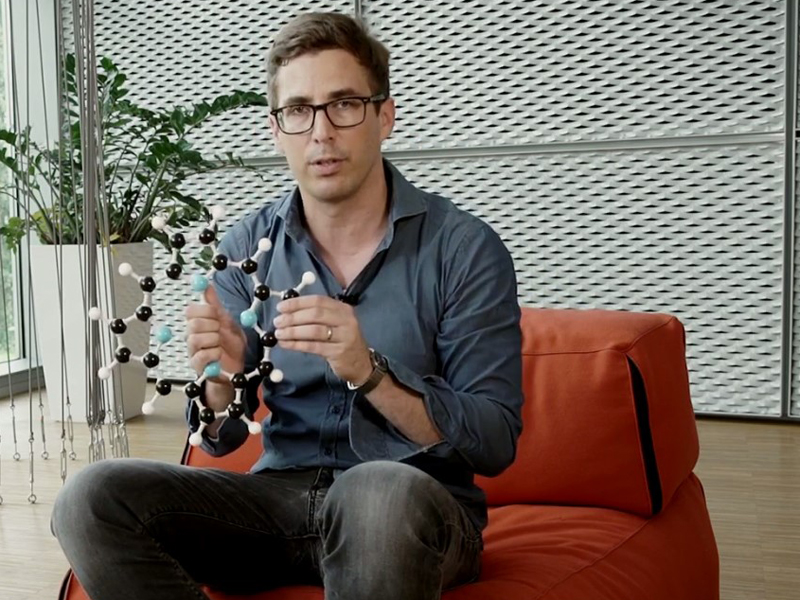
Professor Wilhelm Auwärter with a porphin model. Image: TUM
Many scientists consider graphene to be a wonder material. Now, a team of researchers at the Technical University of Munich (TUM) has succeeded in linking graphene with another important chemical group, the porphyrins. Porphyrins are well-known because of their striking functional properties which for example play a central role in chlorophyll during photosynthesis. These new hybrid structures could also be used in the field of molecular electronics, catalysis or even as sensors.
Hardly any material is currently receiving as much attention in research as graphene. It is flexible, extremely thin and transparent, while at the same time it has very high tensile strength and conducts electricity, ideal prerequisites for a wide variety of application areas. However, using graphene to capture solar energy or as a gas sensor requires other specific properties as well. These properties can be achieved by fusing functional molecules with the carbon layer.
In previous research, scientists were primarily concerned with wet-chemical methods for attaching the molecules to the surface of the material. Together with his colleagues, Molecular Engineering at Functional Interfaces Professor Wilhelm Auwärter decided to take a different approach: They were able to link porphyrin molecules to graphene in a controlled manner in an ultra-high vacuum using the catalytic properties of a silver surface on which the graphene layer rested. When heated, the porphyrin molecules lose hydrogen atoms at their periphery and can thus form new bonds with the graphene edges.
“This method creates a clean and controllable environment,” explains Auwärter. “We can see exactly how the molecules bond and what types of bonds occur.” Here the researchers use the latest in modern atomic force microscopy to depict the chemical structure of individual molecules, the atomic “skeletons,” so to speak.
For the first time the scientists have succeeded in attaching functional molecules to the edges of graphene covalently, i.e. with a stable chemical bond. “We want to modify only the edges of the material; this way the graphene’s positive properties are not destroyed,” says Auwärter.
The researchers chose the porphyrin molecules as the partner for graphene because of their special properties. “For example, porphyrins are responsible for transporting oxygen in hemoglobin,” he continues. The molecules change their properties depending on which metals are at their center and can take on various different tasks, e.g. specifically bonding with gas molecules such as oxygen and carbon dioxide.
In the future this new method may make it possible to bond other molecules to graphene as well. The researchers also want to take even better control of the reaction, achieving targeted modifications by attaching molecules to carbon nanostructures such as graphene ribbons. These nanostructures are of central importance in electronic applications.
This work was supported by the European Research Council (ERC), the Munich Centre for Advanced Photonics, the TUM Institute for Advanced Study as well as the European Union Seventh Framework Programme.
Source: Technical University of Munich




